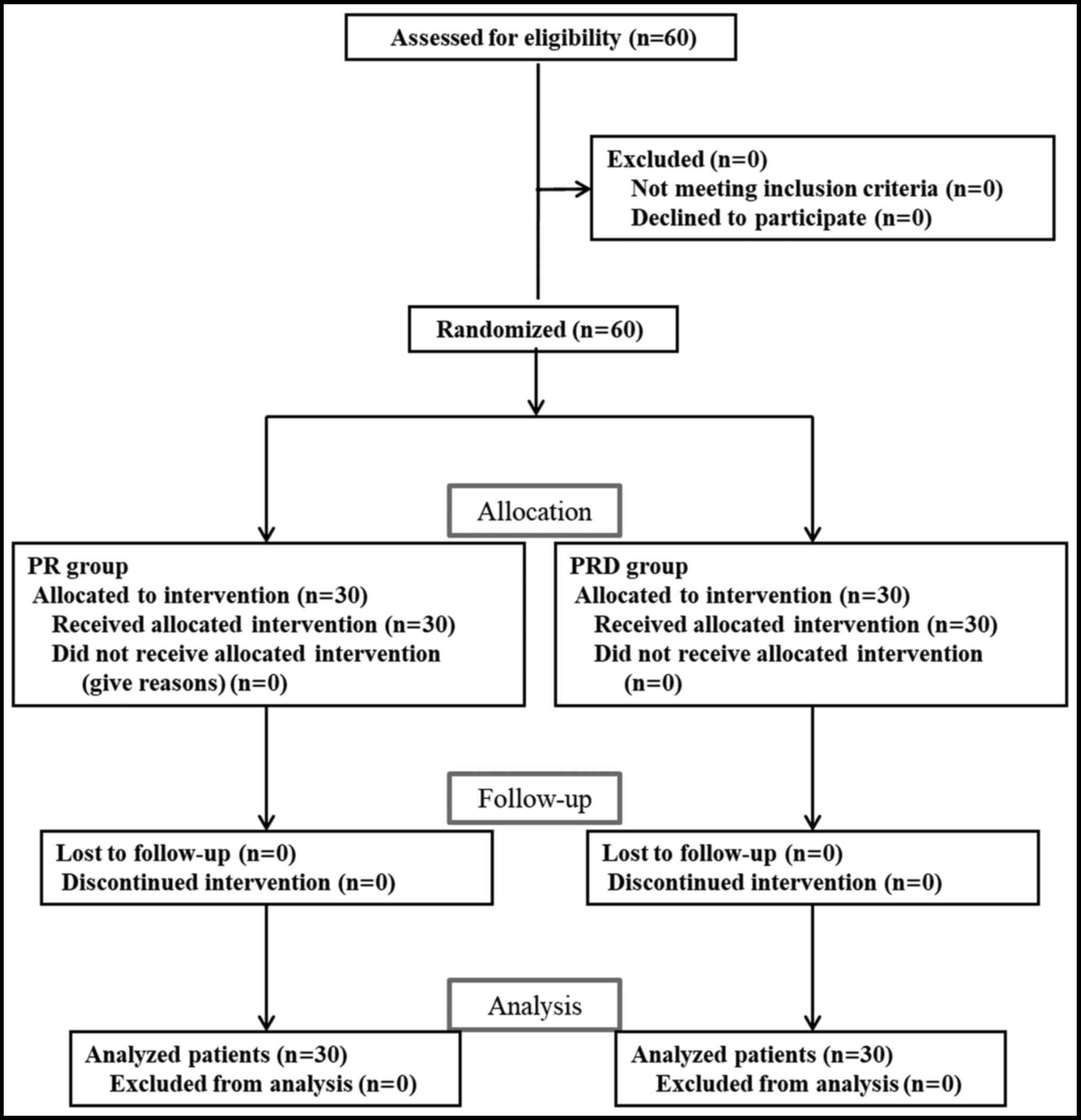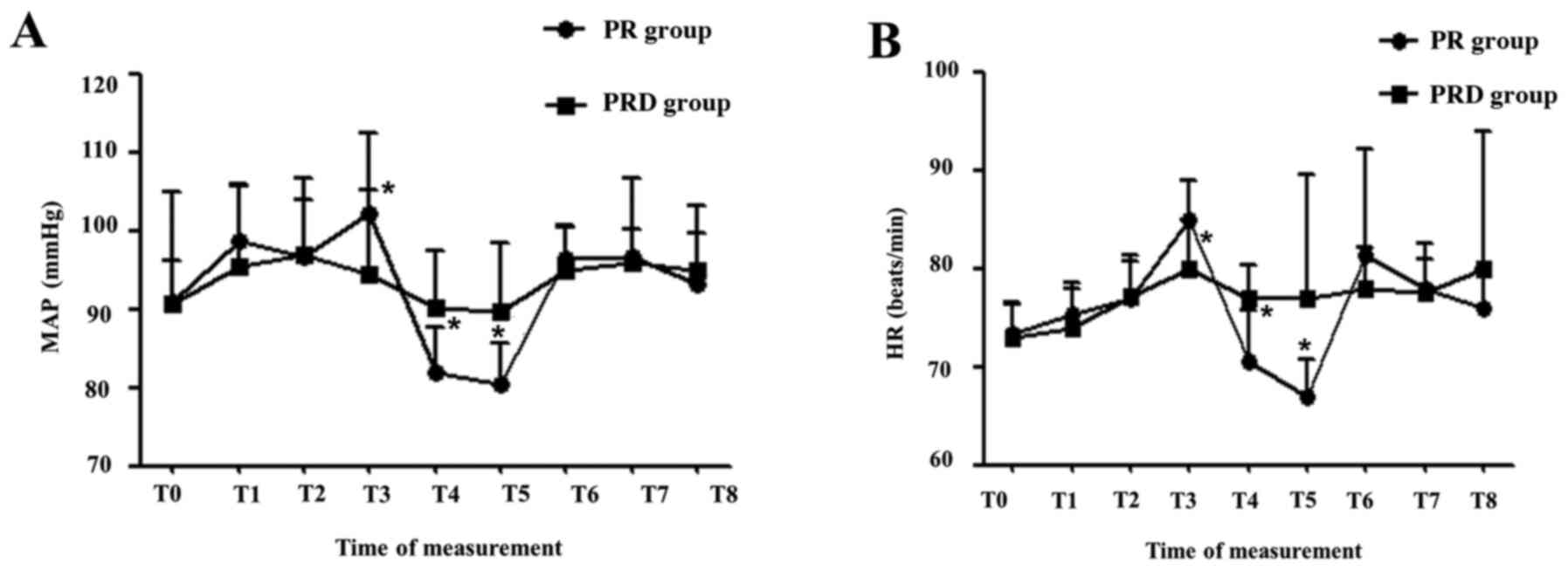|
1
|
Koo YJ, Kim JE, Kim YH, Hahn HS, Lee IH,
Kim TJ, Lee KH, Shim JU and Lim KT: Comparison of laparoscopy and
laparotomy for the management of early-stage ovarian cancer:
Surgical and oncological outcomes. J Gynecol Oncol. 25:111–117.
2014.PubMed/NCBI View Article : Google Scholar
|
|
2
|
Zhang D and Nie A: Assessment of different
anesthesia depth under total intravenous anesthesia on
postoperative cognitive function in laparoscopic patients. J Res
Med Sci. 21(73)2016.PubMed/NCBI View Article : Google Scholar
|
|
3
|
Carli D, Meletti JFA, Neto NEU, Martinez
G, Kim ALC and de Camargo RPS: General anesthesia technique and
perception of quality of postoperative recovery in women undergoing
cholecystectomy: A randomized, double-blinded clinical trial. PLoS
One. 15(e0228805)2020.PubMed/NCBI View Article : Google Scholar
|
|
4
|
Lee WK, Kim MS, Kang SW, Kim S and Lee JR:
Type of anaesthesia and patient quality of recovery: A randomized
trial comparing propofol-remifentanil total i.v. anaesthesia with
desflurane anaesthesia. Br J Anaesth. 114:663–668. 2015.PubMed/NCBI View Article : Google Scholar
|
|
5
|
Ryu JH, Kim JH, Park KS and Do SH:
Remifentanil-propofol versus fentanyl-propofol for monitored
anesthesia care during hysteroscopy. J Clin Anesth. 20:328–332.
2008.PubMed/NCBI View Article : Google Scholar
|
|
6
|
Yoo YC, Bai SJ, Lee KY, Shin S, Choi EK
and Lee JW: Total intravenous anesthesia with propofol reduces
postoperative nausea and vomiting in patients undergoing
robot-assisted laparoscopic radical prostatectomy: A prospective
randomized trial. Yonsei Med J. 53:1197–1202. 2012.PubMed/NCBI View Article : Google Scholar
|
|
7
|
Son I, Oh CS, Choi JW and Kim SH: The
effect of sufentanil administration on remifentanil-based
anaesthesia during laparoscopic gynaecological surgery: A
double-blind randomized controlled trial. ScientificWorldJournal.
2014(701329)2014.PubMed/NCBI View Article : Google Scholar
|
|
8
|
Beier SL, Mattoso CR, Aguiar AJ, Vianna PT
and Massone F: Hemodynamic effects of target-controlled infusion of
propofol alone or in combination with a constant-rate infusion of
remifentanil in dogs. Can J Vet Res. 79:309–315. 2015.PubMed/NCBI
|
|
9
|
Herling SF, Dreijer B, Wrist Lam G,
Thomsen T and Møller AM: Total intravenous anaesthesia versus
inhalational anaesthesia for adults undergoing transabdominal
robotic assisted laparoscopic surgery. Cochrane Database Syst Rev.
4(CD011387)2017.PubMed/NCBI View Article : Google Scholar
|
|
10
|
Bharti N, Chari P and Kumar P: Effect of
sevoflurane versus propofol-based anesthesia on the hemodynamic
response and recovery characteristics in patients undergoing
microlaryngeal surgery. Saudi J Anaesth. 6:380–384. 2012.PubMed/NCBI View Article : Google Scholar
|
|
11
|
Ionescu D, Mărgărit S, Vlad L, Iancu C,
Alexe A, Deac D, Răduţ A, Tudorică G, Necula A and Pop T: TIVA-TCI
(Total IntraVenous Anesthesia-Target Controlled Infusion) versus
isoflurane anesthesia for laparoscopic cholecystectomy.
Postoperative nausea and vomiting, and patient satisfaction.
Chirurgia (Bucur). 104:167–172. 2009.PubMed/NCBI(In Romanian).
|
|
12
|
Yasuda N, Eger EI II, Weiskopf RB,
Tanifuji Y and Kobayashi K: Solubility of desflurane (I-653),
sevoflurane, isoflurane, and halothane in human blood. Masui.
40:1059–1062. 1991.PubMed/NCBI(In Japanese).
|
|
13
|
Eger EI II: New inhaled anesthetics.
Anesthesiology. 80:906–922. 1994.PubMed/NCBI View Article : Google Scholar
|
|
14
|
Jindal R, Kumra VP, Narani KK and Sood J:
Comparison of maintenance and emergence characteristics after
desflurane or sevoflurane in outpatient anaesthesia. Indian J
Anaesth. 55:36–42. 2011.PubMed/NCBI View Article : Google Scholar
|
|
15
|
Kotwani MB and Malde AD: Comparison of
maintenance, emergence and recovery characteristics of sevoflurane
and desflurane in pediatric ambulatory surgery. J Anaesthesiol Clin
Pharmacol. 33:503–508. 2017.PubMed/NCBI View Article : Google Scholar
|
|
16
|
Boat A, Mahmoud M, Michelfelder EC, Lin E,
Ngamprasertwong P, Schnell B, Kurth CD, Crombleholme TM and
Sadhasivam S: Supplementing desflurane with intravenous anesthesia
reduces fetal cardiac dysfunction during open fetal surgery.
Paediatr Anaesth. 20:748–756. 2010.PubMed/NCBI View Article : Google Scholar
|
|
17
|
Daabiss M: American Society of
Anaesthesiologists physical status classification. Indian J
Anaesth. 55:111–115. 2011.PubMed/NCBI View Article : Google Scholar
|
|
18
|
Bredy C, Ministeri M, Kempny A,
Alonso-Gonzalez R, Swan L, Uebing A, Diller GP, Gatzoulis MA and
Dimopoulos K: New York Heart Association (NYHA) classification in
adults with congenital heart disease: Relation to objective
measures of exercise and outcome. Eur Heart J Qual Care Clin
Outcomes. 4:51–58. 2018.PubMed/NCBI View Article : Google Scholar
|
|
19
|
Ead H: From Aldrete to PADSS: Reviewing
discharge criteria after ambulatory surgery. J Perianesth Nurs.
21:259–267. 2006.PubMed/NCBI View Article : Google Scholar
|
|
20
|
Chernik DA, Gillings D, Laine H, Hendler
J, Silver JM, Davidson AB, Schwam EM and Siegel JL: Validity and
reliability of the Observer's Assessment of Alertness/Sedation
Scale: Study with intravenous midazolam. J Clin Psychopharmacol.
10:244–251. 1990.PubMed/NCBI
|
|
21
|
Namigar T, Serap K, Esra AT, Özgül O, Can
ÖA, Aysel A and Achmet A: The correlation among the Ramsey sedation
scale, Richmond agitation sedation scale and Riker sedation
agitation scale during midazolam-remifantanil sedation. Braz J
Anesthesiol. 67:347–354. 2016.
|
|
22
|
Langley GB and Sheppeard H: The visual
analogue scale: Its use in pain measurement. Rheumatol Int.
5:145–148. 1985.PubMed/NCBI View Article : Google Scholar
|
|
23
|
Cho YJ, Bae J, Kim TK, Hong DM, Seo JH,
Bahk JH and Jeon Y: Microcirculation measured by vascular occlusion
test during desflurane-remifentanil anesthesia is superior to that
in propofol-remifentanil anesthesia in patients undergoing thoracic
surgery: Subgroup analysis of a prospective randomized study. J
Clin Monit Comput. 31:989–997. 2017.PubMed/NCBI View Article : Google Scholar
|
|
24
|
Mahli A, Coskun D, Karaca GI, Akcali DT,
Karabiyik L and Karadenizli Y: Target-controlled infusion of
remifentanil with propofol or desflurane under bispectral index
guidance: Quality of anesthesia and recovery profile. J Res Med
Sci. 16:611–620. 2011.PubMed/NCBI
|
|
25
|
Zaballos M, Reyes A, Etulain J, Monteserín
C, Rodríguez M and Velasco E: Desflurane versus propofol in
post-operative quality of recovery of patients undergoing day
laparoscopic cholecystectomy. Prospective, comparative,
non-inferiority study. Rev Esp Anestesiol Reanim. 65:96–102.
2018.PubMed/NCBI View Article : Google Scholar : (In Spanish).
|
|
26
|
Gritti P, Carrara B, Khotcholava M,
Bortolotti G, Giardini D, Lanterna LA, Benigni A and Sonzogni V:
The use of desflurane or propofol in combination with remifentanil
in myasthenic patients undergoing a video-assisted
thoracoscopic-extended thymectomy. Acta Anaesthesiol Scand.
53:380–389. 2009.PubMed/NCBI View Article : Google Scholar
|
|
27
|
Gozdemir M, Sert H, Yilmaz N, Kanbak O,
Usta B and Demircioglu RI: Remifentanil-propofol in vertebral disk
operations: Hemodynamics and recovery versus desflurane-n(2)o
inhalation anesthesia. Adv Ther. 24:622–631. 2007.PubMed/NCBI View Article : Google Scholar
|
|
28
|
Chen PN, Lu IC, Chen HM, Cheng KI, Tseng
KY and Lee KT: Desflurane reinforces the efficacy of propofol
target-controlled infusion in patients undergoing laparoscopic
cholecystectomy. Kaohsiung J Med Sci. 32:32–37. 2016.PubMed/NCBI View Article : Google Scholar
|
|
29
|
Lin CY, Wong CS and Wu CT: Cost analysis
of three anesthetic regimens under auditory evoked potential
monitoring in gynecologic laparoscopic surgery. Acta Anaesthesiol
Taiwan. 46:53–54. 2008.PubMed/NCBI
|
|
30
|
Demeere JL, Merckx Ch and Demeere N: Cost
minimisation and cost effectiveness in anaesthesia for total hip
replacement surgery, in Belgium? A study comparing three general
anaesthesia techniques. Acta Anaesthesiol Belg. 57:145–151.
2006.PubMed/NCBI
|
|
31
|
Seki H, Furumoto K, Sato M, Kagoya A,
Hashimoto H, Sekiguchi Y and Nakatsuka I: Effects of epidural
anesthesia on postoperative nausea and vomiting in laparoscopic
gynecological surgery: A randomized controlled trial. J Anesth.
32:608–615. 2018.PubMed/NCBI View Article : Google Scholar
|
|
32
|
Uchinami Y, Takikawa S, Takashima F, Maeda
Y, Nasu S, Ito A and Saito T: Incidence of postoperative nausea and
vomiting is not increased by combination of low concentration
sevoflurane and propofol compared with propofol alone in patients
undergoing laparoscopic gynecological surgery. JA Clin Rep.
5(70)2019.PubMed/NCBIDOI: 10.1186/s40981-019-0292-4.
|
|
33
|
Marana E, Russo A, Colicci S, Polidori L,
Bevilacqua F, Viviani D and Di Stasio E: Desflurane versus
sevoflurane: a comparison on stress response. Minerva
anestesiologica. 79:7–14. 2013.PubMed/NCBI
|
|
34
|
Roh GU, Song Y, Park J, Ki YM and Han DW:
Effects of propofol on the inflammatory response during
robot-assisted laparoscopic radical prostatectomy: A prospective
randomized controlled study. Sci Rep. 9(5242)2019.PubMed/NCBI View Article : Google Scholar
|
















